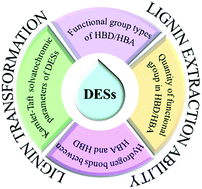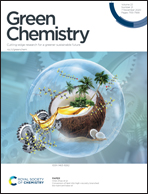Structure–function relationships of deep eutectic solvents for lignin extraction and chemical transformation†
Abstract
Lignin is the most abundant natural aromatic feedstock, and the conversion of lignin to value-added chemicals has drawn immense attention in biorefineries. Deep eutectic solvents (DESs) have been used for lignocellulosic biomass fractionation and lignin extraction due to their simple procedure, selective solubility of lignin, low cost, and high recyclability. The nature and number of functional groups in DESs remarkably influence the delignification and structural changes of lignin during treatment. Although many studies have investigated lignin extraction and the following chemical transformations during DES treatment, no review has illuminated the structure–function relationships between DESs and lignin. This review presents a systematic overview of important studies to provide insights into lignin extraction and chemical transformations by examining the relationship between the type and number of functional groups in DES constituents during pretreatment. Furthermore, various challenges and opportunities in the development of more sustainable and efficient lignin extraction are provided according to the remaining problems in this field.



 Please wait while we load your content...
Please wait while we load your content...